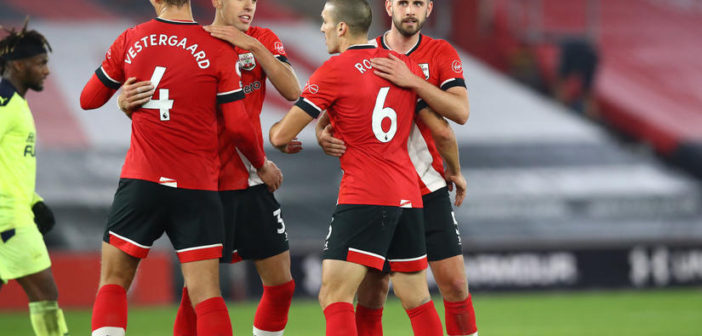Forget the frequent acts of marvelling when Southampton are without the ball, watch what happens when they’ve got it.
Saints’ high pressing-game has long been the cornerstone of Ralph Hasenhuttl’s tenure. It’s simply the hallmark of the team, the first topic that naturally transpires in conversation when the club is brought into it.
Countless eulogies have been spoke and untold tributes written on Southampton’s extraordinary, kamikaze approach to pressing, whether it’s from supporters or outside observers looking in. Watching it up-close and in the flesh leaves you awestruck. In fact, every time you see it, that particular feeling never seems to lessen. It is a timeless emotion which can only be compared to an exhilarating rollercoaster ride of unpredictability. Ever since December 2018 and a certain Austrian walked in and breathed life back into a soulless Staplewood has it been that way.
In essence, the intoxicating press was the earliest signs of supporters taking Hasenhuttl into their hearts and capturing their minds. They and pundits alike are often still left marvelling at his intangible knack of extracting every last ounce of energy from his side.
Ask any supporter from any football club, they will always say the most important their team can do is work hard. And by god, no team works harder than Southampton.
They take pressing and onerous toil to the extreme, suffocating opposition through an incessant urge to win the ball back and a machinable power to sustain it. Counterparts are left dizzy and desperately weary, having become stuck in a vice-like grip that only ceases once the final whistle has been blown. Sure, this particular methodology of football carries a huge physical and psychological burden on each member of the squad, but never one that seems too damning.
But this season, Southampton’s all-action style has been given a refinement. No longer does a match involving Saints resemble a game of ping-pong, where turnovers are aplenty and anarchy ensues in just about every area of the pitch.
Forecasts have long been made over Southampton’s progression under Hasenhuttl, where the next-step is for this captivating manager and team. Could together, they discover a style with the ball to compliment their already well-oiled machine without it? Against Newcastle, every pending prognosis was answered emphatically.
Unsurprisingly, Saturday morning’s headlines focused on Saints reaching the summit of the English game, even if it was only going to be a passing visit. After all, it was the first time in 32 years and the first time in Premier League history the club had achieved such a feat. More relevantly, they had now recorded three consecutive victories in over four years (May 2016).
Confidence is palpable among players, staff and supporters. Not since the lofty heights of Ronald Koeman’s Europa League excursions have Saints been so sure in their methods and ideology. Most will put it down to Saints finally having the fruits of their out of possession labour bared for all to see.
But you only need to look towards the back to find the real answers.
A key staple to Southampton’s ascension towards the mountaintop is their steep development when in possession. And like all worthwhile things, it started from the bottom (of the pitch, anyway).
Make no bones about it, the evolution in playing out from the back is the greatest stride Saints have made in recent times. It has grown to embody the confidence that currently seeps through the entire squad.
“This was definitely the biggest development we have made in this season so far,” Hasenhuttl said, when asked on this subject. “We are very calm, we have good game management and we are definitely finding the different levels between the lines much better now, with much more patience.”
They’ve become more technical in their precision of playing through the thirds, relying on genuine quality to deliver incisive passes through the lines, as opposed to a more visceral-based approach.
If you trace back to Southampton goal kicks from last season, there was a ‘kick and run’ feel to it. Patterns of play that stemmed from the back would resemble a rugby game, where they would want to get the ball into attacking half as quickly as possible and away from their own goal, as quickly as possible.
At times it would be effective and in others, it would become a direct detriment to the team. It’s likely Hasenhuttl knew such a rudimentary style of playing would always come with certain drawbacks, but given the flailing confidence and apparent lack of technical guile, Hasenhuttl opted to persist with it.
Aside from goal kicks, there was an uneasiness in retaining possession in their own half. The defence was unsettled and vulnerable and had more pressing matters of concern than what they did on the ball; they had to worry about keeping it out of their goal first and foremost.
Fortunately for them, their manager is a confident man. Hasenhuttl is a risk-taking manager, one that never rests or settles for mediocrity. This pre-season, he identified the next step was advancing the sides capabilities in playing-out from the back and at a regular success rate. He wanted them to add a variation to their play, a subtle extra facet that would compliment their high-pressing assortments.
Hasenhuttl actively encouraged his centre-backs to seek the ball from Alex McCarthy and be brave and purposeful in their decision-making. Every action taken would have to be executed with 100% commitment.
Mitigating factors also helped, such as the introduction of Jannik Vestergaard into the starting line-up. The Dane’s inclusion allowed both centre-backs to instantly feel more comfortable. Vestergaard is an accomplished passer with either foot, which has meant he offers the ability to play through the lines quickly and accurately, without having to shift the ball onto his preferred boot.
Vestergaard moved into the left-sided role of central defence, enabling Jan Bednarek to shift across to right-side, in a far more suited role. When Bednarek had played with Jack Stephens, he would appear rather basic in his ball-playing dexterity, due to natural tendency to exclusively use his right foot. This meant more advantageous passing lanes were cut-off, causing him to take the safer, less effective option most of the time.
But now playing in a better-tailored position to suit his natural qualities, it has opened up his range of passing options, increased the angles of his teammates and developed an overall confidence in himself taking risks. Not only has Vestergaard’s inclusion given Bednarek a help-in-hand, but has added a multitude of dimensions to the team in general, particularly if Plan A isn’t working. Last season, when an initial idea wouldn’t work, they would resort to kicking the ball long. Nowadays, they are considerably more patient.
But the game against Newcastle underlined the vast progress made. It was a joy to watch for all those who didn’t share an affinity to black and white. Bednarek and Vestergaard epitomised all that was good with Southampton’s ball retention. Throughout, there was an unwavering confidence, which would occasionally border on a delightful arrogance.
Alex McCarthy now has varied passing options, all capable of building through the phases of attack
The progression is real. It was chalk and cheese, night and day from last season. Whatever the juxtaposition you want to use to show the contrast, that was it. Instead of playing long, they played short. Panic was replaced with tranquillity. It was so daring, so glaringly different that, at times, Southampton would hold onto the ball a split second longer, just to dare Newcastle attackers to press.
Vestergaard would regularly walk with the ball and slow the tempo of the game down. He would take a touch extra, waiting for Callum Wilson to get a yard closer to him, before offloading it to the spare man at the back. With Allan Saint-Maximin hardly the most enthusiastic presser, Southampton coaxed Newcastle forwards into nomansland, where they would find themselves trying to close down, but without the intensity or system in place behind them to do it well.
By Vestergaard delaying the pass, it meant Southampton’s ball-playing backline absorbed Newcastle shirts onto them, only to change gears when attempting to capitalising on the vacated Newcastle space.
It is well documented Hasenhuttl’s Saints do their best, most efficient work in the ‘red zone’ – the condensed area between opposition centre-backs and their central midfielders – and Steve Bruce knew all about this.
But Southampton’s teasing left Newcastle and Bruce faced in tactical limbo. The ball appeared to be there to win, but wasn’t quite close enough. Just when the visitors were sufficiently teased enough by the thought of winning the ball (Saints defenders taking risks as well as an extra touch), Hasenhuttl orchestrated a change of gear.
The manager’s cries of “calm!” and “quicker!” beautifully conducted the tempo in Saints’ play, personally deciding when and where was the right time to slow down or speed the game up. When the latter instruction did arrive, the end answer often produced a chance that was fashioned from the red zone.
The variation in Southampton’s play is on such a highly-technical level, Newcastle seemed utterly stuck. They simply could not deal with the constant paradoxes in Saints’ play, from building slowly to suddenly ambushing them with a series of quick, laser-like passes through the middle.
Sometimes, they would keep the ball out wide, only to spring an attack by carving through the middle. Unpredictably was at its finest and consigned Bruce to a befuddled, hands on hips pose for much of the evening.
The alteration of rhythm intertwined with the quality to produce accurate passes with incision, is quite staggering. In the first-half, goalkeeper McCarthy dummied a long ball only to play a blind pass to Bednarek, taking Sean Longstaff out of the game. Minutes later, Vestergaard played a popping one touch pass – with his apparent weaker foot – through two players to James Ward-Prowse. Two actions, from two on the last line of defence, shows confidence severely impacts on success rate.
In the image below, Oriol Romeu takes an extra touch before passing to Vestergaard, teasing three Newcastle players to press:
Romeu’s offload to Vestergaard is a trigger to change the tempo. Vestergaard plays a one touch pass to Ward-Prowse, taking out three Newcastle in once action. The attack results in a dangerous opening for Theo Walcott.
Southampton played like that from start to finish. In the 91st minute, Romeu was still dropping to the edge of the box to receive. That is Ralph Hasenhuttl. A manager that will change for no one, at no time, under no circumstance.
Instead of changing, he refines and fortifies every element of his sides game. He is wedded to thrilling, risk-taking football, the type which makes you remember why you fell in love with football in the first place.
Southampton fluctuate gears at ease and display a delightful arrogance that accompanies it. Hasenhuttl is the conductor and his men are the harmonic choir that perform the perfect tune.
Times like these do not happen very often. And neither does performances of that quality.
Follow us on Twitter @ProstInt
![Prost International [PINT]](https://prostinternational.com/wp-content/uploads/2021/08/PINTtFontLogoRoboto1536x78.jpg)



